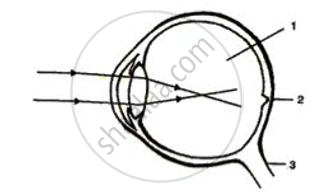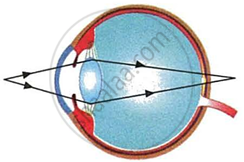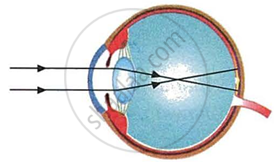Advertisements
Advertisements
प्रश्न
Given alongside is a diagram depicting a defect of the human eye. Study the same and then answer the questions that follow:
(i) Identify the defect.
(ii) Name the parts labelled 1, 2 and 3.
(iii) Give labelled two possible reasons for this eye defect.
(iv) Draw a labelled diagram to show how the above mentioned defect is rectified.

उत्तर
(i) Myopia.
(ii) 1. Vitreous humor
2. Fovea
3. Optic nerve
(iii) 1. Lengthening of the eyeball from front to back.
2. Lens is too curved.
(iv) Correction of Myopia:

APPEARS IN
संबंधित प्रश्न
List three common refractive defects of vision. Suggest the way of correcting these defects.
The kind of lens required to correct Myopia
What is the other name for
myopia
Where is the near point of a person suffering from hypermetropia (or long-sightedness)?
Your friend can read a book perfectly well but cannot read the writing on blackboard unless she sits on the front row in class.
Is she short-sighted or long-sighted?
A man can read the number of a distant but clearly but he finds difficulty in reading a book.
From which defect of the eye is he suffering?
A person having short-sight cannot see objects clearly beyond a distance of 1.5 m. What would be the nature and power of the corrective lens to restore proper vision?
A young man has to hold a book at arm's length to be able to read it clearly. The defect of vision is:
(a) astigmatism
(b) myopia
(c) presbyopia
(d) hypermetropia
A person can read a book clearly only if he holds it at an arm's length from him. Name the defect of vision:
if the person is an old man
Describe the mechanism of focusing the image of a distant object in your eye when you raise your head after reading a book.
A person cannot read newspaper placed nearer than 50 cm from his eyes. Name the defect of vision he is suffering from. Draw a ray diagram to illustrate this defect. List its two possible causes. Draw a ray diagram to show how this defect may be corrected using a lens of appropriate focal length.
Observer the following diagram and answer the questions.
a) Which eye defect is shown in this diagram?
b) What are the possible reasons for this eye defect?
c) How this defect is corrected, write it in brief?

Have a look at the posture of this woman who is reading a book and answer the questions which follow:

What kind of looking glasses she needs?
Give Reason:
Older people require glasses to read and write.
Draw a neat labeled diagram to show how hypermetropia can be rectified.
Given below is a diagrammatic representation of a defect of the human eye:

(i) Identify the defect.
(ii) Mention two reasons for the above defect.
(iii) State how the defect can be rectified.
(iv) Name the part of the eye responsible for maintaining the shape of the eyeball.
Correlate the given sequence:
Hypermetropia : Convex lens : ______ : Concave lens
Have a look at the posture of this girl who is reading a book and answer the questions which follow:
 |
- Name the problem she is facing.
- What are the two conditions shown in sections A and B of the eye as applicable to her.
- What kind of reading glasses does she need?
 |
 |
| A | B |
